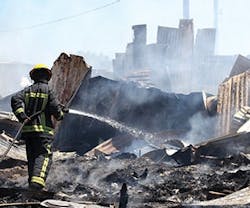If you think arson is a rarity, think again. According to the U.S. Fire Administration, there were 8,500 prosecuted arson cases in 2010. Because this crime is difficult to prove, reported incidences likely represent only a fraction of deliberate fires each year.
Bernie Arends, who served as an origin and cause fire investigator for over 30 years and currently works as a sales associate for Inspection Reports Online, and Alan Major, a fire/life safety trainer for Universal Protection Service who served on the Santa Monica Fire Department for 34 years, share valuable tips that can protect properties against arson.
Why should building owners be
concerned about arson?
Major: There are no property types that are immune to arson. Arson occurs for a variety of reasons, such as revenge, fraud, a cover-up to another crime, protest, or a random act of vandalism. Arsonists often repeat the act if there are no consequences.
Arends: Arson is the most expensive crime in the United States when you take into account property damage, disruption of business continuity, insurance settlements, and sometimes loss of life. Many fires that are listed in national statistics as “undetermined” are actually deliberate. It is estimated that half of the fires in this country are intentionally versus accidentally set, but the conviction rate for arson is less than 5%.
What preventive measures can decrease the likelihood of arson?
Major: Good property policies and procedures are the best way to prevent arson. A risk assessment should be conducted to find a facility’s weak spots and provide a basis to implement improvements. Review your assessment whenever the building undergoes a major change such as construction, clientele type, or staffing.
Arends: You need to look at all of the internal and external vulnerabilities of your facility. Installed systems such as fire alarms and fire sprinklers are the most valuable assets, but who controls access to these vital systems? Doors to fire alarm panels and sprinkler controls should have restricted access to prevent someone from setting a fire more easily by shutting down the systems.
Major: Never overlook the importance of having up-to-date evacuation plans and practicing fire drills with occupants.
Also be mindful of activities on your property. Labor disputes or public demonstrations that are not managed and supervised can create an opportunity for arson and other crimes. PageBreak
What fire protection and monitoring systems can support arson detection?
Arends: Rely on the concept of balanced fire protection. In addition to active systems such as fire sprinklers and fire alarms, this approach includes passive measures such as fire-rated corridors, enclosed exit stairwells, emergency exits, and other items in the building code to protect occupants.
Major: Arson usually occurs in areas where the perpetrator is not seen. Ensure access and egress points are well-illuminated and aren’t hidden from view by walls, hedges, or other barriers. Post security staff in high-risk areas or use surveillance systems to monitor vulnerabilities. Confirm that exit points open freely in the direction of exit travel and can be locked from the outside.
If arson is suspected, what steps should building management take?
Major: Always report a fire to your local fire department. Authorities will most likely conduct an investigation if arson is suspected. The building or section involved will remain in the custody of the investigating agency until all evidence is collected and a complete forensic evaluation is made. Private insurance agencies may also want to conduct their own investigation after local authorities have finished.
Arends: When the local police and fire respond, ask if they have a fire investigation team. If not, your insurance company will have a certified cause and origin fire investigator available. These professionals have experience with collecting and preserving evidence.
They will have photos taken of every part of the building, whether it was involved in the fire or not, to look for valuable information. You can also have photos of your facility ready in advance to help investigators reconstruct the scene after a fire.
Jennie Morton [email protected] is associate editor of BUILDINGS.
About the Author
Jennie Morton
A former BUILDINGS editor, Jennie Morton is a freelance writer specializing in commercial architecture, IoT and proptech.
